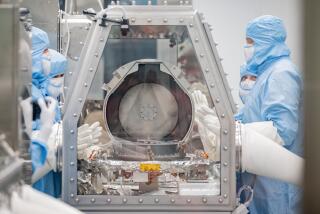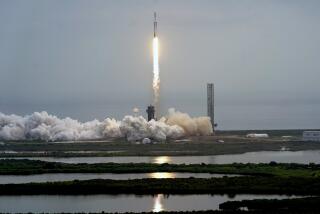As Dawn heads to dwarf planet, NASA set to touch deadly asteroid
The spacecraft Dawn has been visiting Vesta, an Arizona-sized chunk of lumpy rock in the asteroid belt between Mars and Jupiter. Now the NASA spacecraft will head to the dwarf planet Ceres.
As the Associated Press reports, Dawn orbited Vesta for a year, taking photos and using various instruments to explore the asteroid from as close as 130 miles.
But NASA isn’t done with asteroids. Today the space agency launched a name-the-asteroid contest as efforts geared up to bring a piece of an asteroid home to Earth. And we’re not talking just any asteroid.
PHOTOS: Awesome images from space
This identified flying object -- now known as (101955) 1999 RQ36 -- “is the most exciting, accessible volatile and organic-rich remnant from the early solar system, as well as the most potentially hazardous asteroid known to humanity.”
So says the University of Arizona website devoted to the OSIRIS-REx Asteroid Sample Return Mission. Why so dangerous? Of any known asteroid, 1999 RQ36 has the greatest probability of smacking into Earth within the next few centuries, according to the project, which is managed at NASA’s Goddard Space Flight Center.
Scientists have deduced that the asteroid is fairly smooth and shaped like a “spinning top.” It’s 493 meters (1,617 feet) in mean diameter, and the plan is to bring back as much as 2 kilograms of that rock. Scientists hope, among other things, to glean insights to the early solar system by studying this material, as well as gain more conclusive data on how and when this asteroid might hit Earth.
Right now, scientists are predicting that the object could impact Earth in the late 22nd century.
OSIRIS-REx will use “touch-and-go-sampling” to collect material from the asteroid, a method that, according to the university’s website, is a “five-second, very light” maneuver.
But before any of this happens, NASA wants to stop calling this asteroid (101955) 1999 RQ36.
So the space agency as asking those 18 and younger to send in their ideas.
Contest rules, guidelines and an application are at www.planetary.org/name. The deadline is Dec. 2. The contest is for kids, but it’s not a childish endeavor. As the project points out, the asteroid is a potentially lethal object, and the mission is a lengthy one.
The mission is expected to last about 14 years, and analyses should extend for decades beyond that, “with scientists not yet born making use of techniques we have yet to invent.”
That’s heady stuff.
ALSO:
Voyager 1 set to burst solar system bubble
Man who discovered Kuiper Belt needs to locate a tuxedo
Report flips switch and human genome comes to wriggling life
Join Amy on Google+. Email: amy.hubbard@latimes.com
More to Read
Sign up for Essential California
The most important California stories and recommendations in your inbox every morning.
You may occasionally receive promotional content from the Los Angeles Times.











